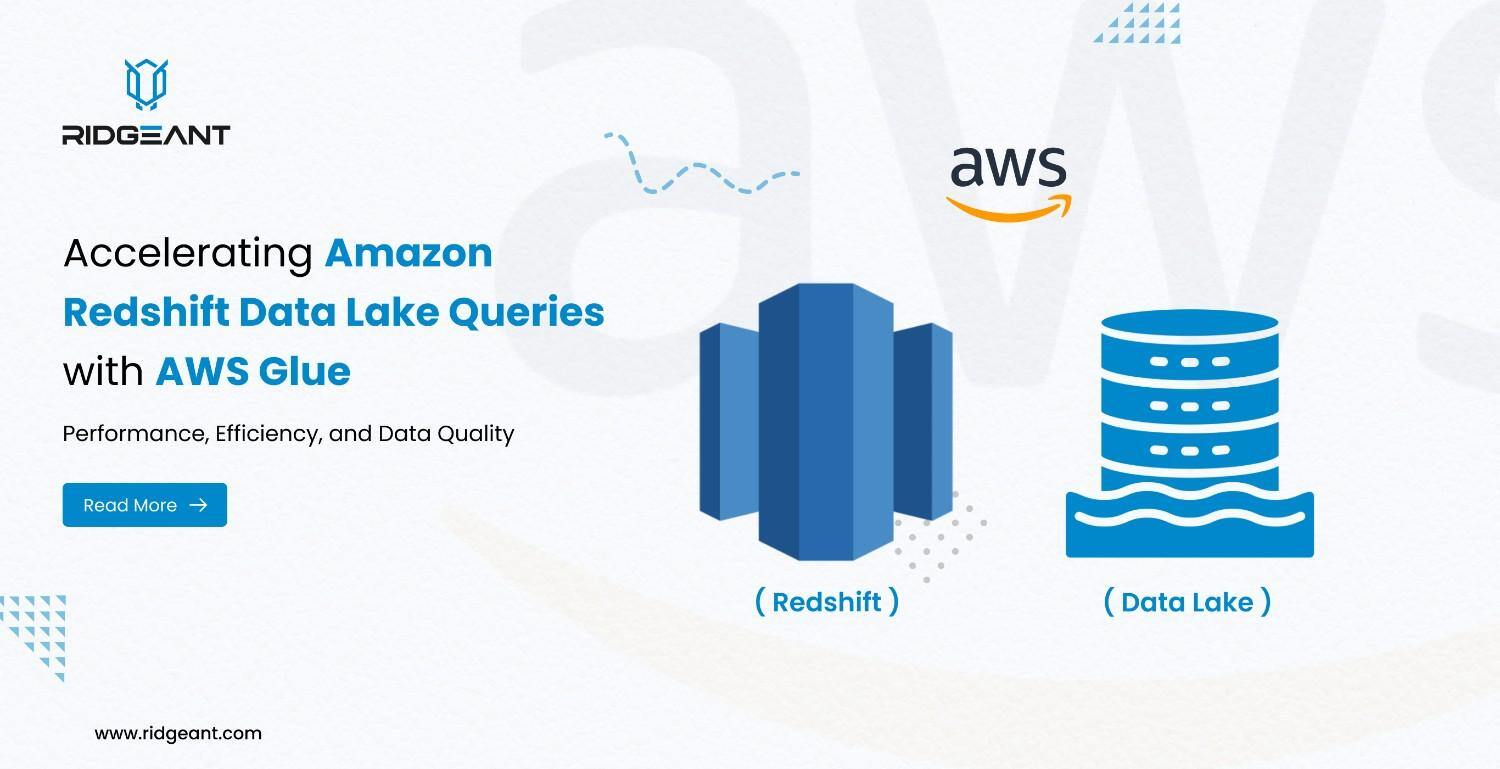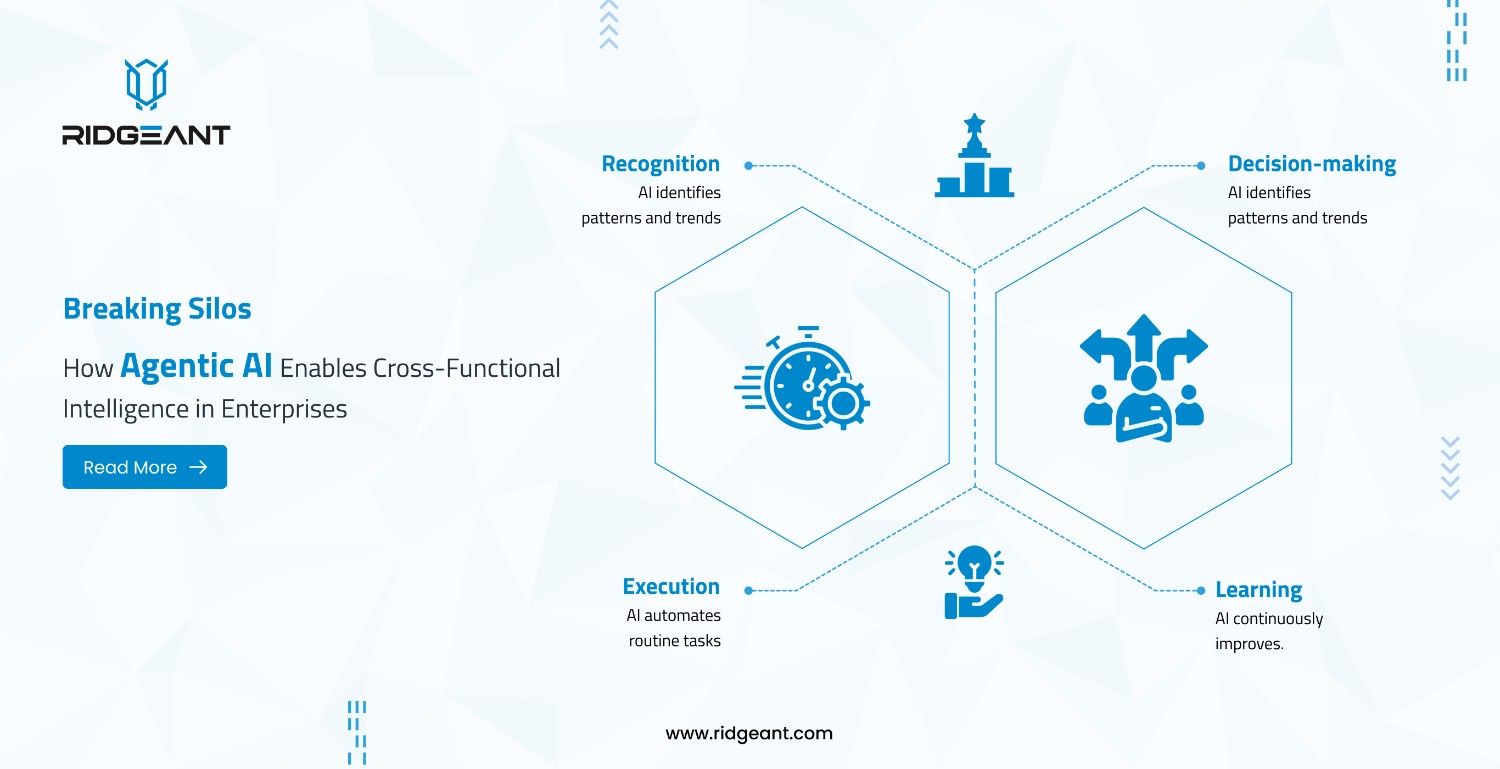
Accelerating Amazon Redshift Data Lake Queries with AWS Glue: Performance, Efficiency, and Data Quality
- Data Analytics, Data Science, Tableau
- November 15, 2024
- Ridgeant

AWS for Modern Data Analytics
As businesses increasingly turn to data-driven insights to fuel growth and innovation, cloud solutions like Amazon Redshift and AWS Glue have emerged as powerful allies for processing and integrating vast amounts of data efficiently. The demand for real-time insights from data lakes has led to ongoing enhancements in Amazon Redshift and AWS Glue, particularly in the dominion of data lake queries. To stay competitive, organizations are looking to optimize query performance, reduce data integration time, and ensure data quality—all areas where AWS technologies excel.
Good Read: AWS Data Engineering – Here is a Definitive Guide
Key Statistics Highlighting AWS Capabilities:
- Performance Boosts in Amazon Redshift: Recent updates to Amazon Redshift’s data lake query capabilities have delivered impressive gains. For example, the TPC-DS 3 TB benchmark test demonstrated up to a 3x overall execution time improvement, with some individual queries experiencing up to a 12x speedup.
- Reduced Data Integration Time: With AWS Glue, users can now merge and analyze data in minutes rather than months, dramatically improving time-to-insight for businesses.
- Extensive Data Source Compatibility: AWS Glue Data Catalog supports over 80 data sources, including various cloud and on-premises databases, allowing for seamless data integration across diverse environments.
- Serverless Efficiency: By eliminating infrastructure management, AWS Glue’s serverless architecture not only cuts operational costs but also enables users to focus resources on processing, analytics, and business outcomes.
- Automated Code Generation: AWS Glue can automatically generate ETL scripts in popular languages like Scala and Python, reducing manual coding effort and supporting parallel processing for large-scale workloads.
- Data Quality Monitoring: AWS Glue Data Quality tools provide automatic monitoring and measurement of data quality, enabling businesses to make better decisions based on reliable data.
This blog explores how organizations can accelerate data lake queries on Amazon Redshift by leveraging AWS Glue’s ETL, cataloging, and integration features, with insights into the performance improvements, data quality enhancements, and cost efficiencies gained.
Optimizing Data Lake Query Performance with Amazon Redshift
One of the key features of Amazon Redshift is its ability to query data across both its local storage and Amazon S3 data lakes using Redshift Spectrum. By connecting Amazon Redshift to data lakes in S3, organizations gain the ability to analyze vast amounts of structured, semi-structured, and unstructured data without needing to move it into a traditional data warehouse. This integration brings significant speed and efficiency improvements, especially with recent optimizations in query performance.
Recent Performance Gains
Amazon’s updates have optimized query performance considerably, with benchmarks showing significant improvements. For example:
- Up to 12x Faster Queries: Certain complex queries on the TPC-DS benchmark experienced a 12x performance boost, making it possible to extract insights from data lakes at unprecedented speeds.
- 3x Overall Speed Improvement: Across the entire benchmark, Amazon Redshift demonstrated a 3x increase in query execution speeds, reducing the time needed for analytics workflows and enabling quicker decision-making.
These optimizations allow businesses to leverage large-scale analytics without the typical bottlenecks that come with querying vast data lakes, creating faster pipelines and accelerating data-to-insight conversion.
AWS Glue: The trailblazer in Data Integration
AWS Glue’s unique features for ETL (Extract, Transform, Load) operations streamline the complex process of preparing data for analysis. With AWS Glue, organizations can reduce time-to-insight by automating much of the traditionally manual ETL process.
Key Features Driving Data Integration Efficiency
- Automatic ETL Code Generation: AWS Glue simplifies the creation of ETL scripts by automatically generating them in either Scala or Python. This automation enables developers to quickly set up ETL processes, significantly lowering the entry barrier and reducing time spent on data preparation.
- Serverless Architecture for Cost Efficiency: As a serverless service, AWS Glue eliminates the need to manage infrastructure. Organizations are billed only for the resources consumed, making Glue a cost-effective solution that supports high levels of operational efficiency.
- Extensive Data Cataloging: AWS Glue’s Data Catalog acts as a centralized repository for metadata, supporting over 80 data sources. It allows organizations to seamlessly integrate structured and semi-structured data from both cloud and on-premises environments, providing a unified view of data assets.
- Quick Data Integration with AWS Glue Jobs: AWS Glue Jobs enable users to transform and load data into Amazon Redshift efficiently. By executing these ETL jobs in parallel, AWS Glue accelerates the process of data preparation and integration, enabling quicker insights.
Good Read: ETL Vs ELT
AWS Glue’s capabilities in streamlining ETL processes, coupled with its serverless architecture, have made it a preferred choice for organizations looking to maximize the value of their data lakes with minimal effort and cost.
Enhancing Data Quality and Visibility with AWS Glue
In data analytics, the quality of insights is only as good as the quality of the underlying data. Poor data quality can lead to inaccurate insights and misguided business decisions. Recognizing this, AWS Glue has introduced tools for data quality monitoring, which automatically assess and flag data anomalies, ensuring that businesses operate with reliable, high-quality data.
Data Quality Monitoring: Ensuring Reliable Insights
- Automatic Data Quality Checks: AWS Glue’s data quality monitoring tools allow users to define data quality rules. These rules are automatically applied to data pipelines, ensuring that data quality is continuously monitored and maintained.
- Data Visibility with AWS Glue Data Catalog: Acting as a central metadata repository, AWS Glue Data Catalog gives users visibility into their data assets, making it easy to locate, manage, and query datasets across the organization.
With AWS Glue’s focus on data quality and metadata management, businesses can be confident that their insights are derived from accurate, high-quality data, reducing the risk of errors and enhancing decision-making capabilities.
Real-World Applications: Success Stories of AWS Glue and Amazon Redshift
The synergy between Amazon Redshift and AWS Glue has delivered impactful results across industries. Below are some real-world examples:
Retail Industry
Retail companies often manage large, diverse data sources, such as inventory, sales, customer interactions, and supply chain data. By integrating AWS Glue and Amazon Redshift, retailers can analyze data from multiple sources, enabling faster inventory management and personalized marketing. For example, a major retailer used AWS Glue to merge data from several warehouses and run Redshift queries that helped forecast demand and manage stock more accurately, reducing out-of-stock incidents by 15%.
Healthcare Sector
In healthcare, data is critical for patient outcomes and research. One healthcare provider used AWS Glue to automate the ETL process for integrating patient records, research data, and clinical trial results. By using Amazon Redshift to query the data in their S3-based data lake, they significantly reduced data integration time, allowing researchers and clinicians to gain insights in real-time and ultimately improve patient care.
Financial Services
Financial institutions leverage AWS Glue and Redshift for real-time fraud detection and compliance reporting. One bank used AWS Glue to process transaction data from multiple sources, combining it with Redshift Spectrum to detect suspicious patterns. This setup not only streamlined compliance reporting but also enabled the bank to reduce fraud losses by 25% by identifying and acting on anomalies in near real-time.
Looking Ahead: The Future of Data Lake Analytics with Amazon Redshift and AWS Glue
As the volume of data continues to grow, the need for efficient data lake analytics becomes more pressing. Amazon Redshift and AWS Glue are likely to continue evolving to meet this demand. Upcoming enhancements may include:
- Enhanced Machine Learning Capabilities: Machine learning models that run directly within AWS Glue and Amazon Redshift are likely to gain popularity, enabling predictive analytics and deeper insights directly within data pipelines.
- Greater Data Quality Automation: We may see additional AI-driven quality checks and anomaly detection, allowing businesses to ensure even more reliable data for decision-making.
- Integration with Other Cloud Providers: As multi-cloud strategies gain traction, AWS Glue and Amazon Redshift may offer enhanced interoperability with other cloud providers, allowing companies to leverage their existing infrastructure while still accessing AWS’s powerful analytics capabilities.
Conclusion
By combining Amazon Redshift’s performance enhancements with AWS Glue’s data integration and quality features, organizations can unlock new levels of data lake efficiency, cost-effectiveness, and reliability. Whether streamlining ETL processes or boosting query speeds, these AWS tools empower businesses to gain faster, more accurate insights and make better data-driven decisions. As the ecosystem around data analytics evolves, AWS Glue and Amazon Redshift are positioned to play a crucial role in the future of data lake analytics, enabling organizations to keep pace with their growing data needs.














